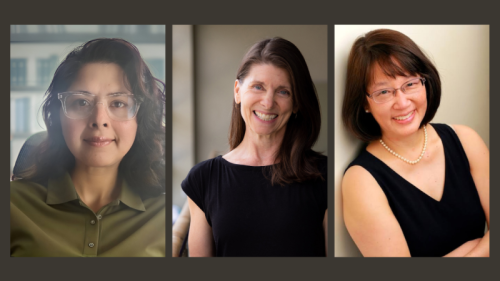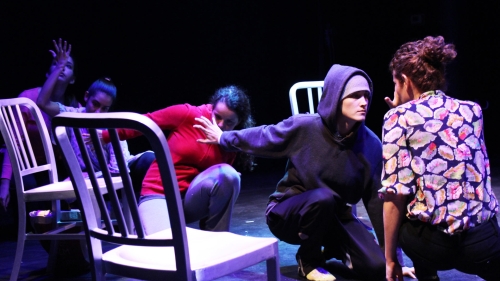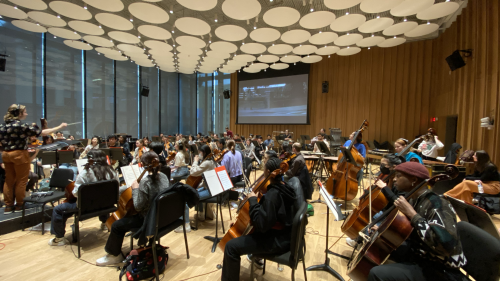
From left: NYU Steinhardt Director Drama Therapy, Dr. Nisha Sajnani with Dr. Jill Sonke and Dr. Lisa Wong
Arts and culture enrich our lives, our communities, and our nation. In this pivotal moment in our history, there is a growing recognition that the arts reveal new ideas, unlock opportunities, and help us confront the many challenges before us. On January 30, 2024, the White House Domestic Policy Council and National Endowment for the Arts (NEA) co-hosted Healing, Bridging, Thriving: A Summit on Arts and Culture in our Communities, a first-of-its-kind convening to share insights and explore opportunities for arts organizations and artists to contribute to the health and well-being of individual and communities, invigorate physical spaces, fuel democracy, and foster equitable outcomes. In this blog series, you’ll hear from the many diverse perspectives represented at the event—including government officials, policymakers, artists, advocates, academics, and arts leaders—as they share what ideas and inspiration they took from the experience, and how they’re working to advance a broader understanding of how arts and culture can contribute to other fields and unlock new opportunities for artists.
One day before the Healing, Bridging, Thriving summit, we convened an arts and health caucus to consider this question: What is one idea or action that you think could help us realize the potential that the arts have in clinical and public health in the United States? We invited government officials, health care providers, artists, educators, researchers, funders, private agency and public policy representatives.
As conveners, we each brought experience in national and international efforts to advance research and create opportunities to integrate evidence-based arts practices and interventions in clinical and public health. Dr Nisha Sajnani is a theater artist and Associate Professor of Drama Therapy at NYU Steinhardt, Chair of the NYU Creative Arts Therapies Consortium, and Founding Co-Director of the Jameel Arts & Health Lab established in collaboration with the World Health Organization; Dr. Jill Sonke is a dancer and the Director of Research Initiatives at the Center for Arts in Medicine at the University of Florida and Director of National Research and Impact, One Nation/One Project; and Dr. Lisa Wong is a musician and an Assistant Professor of Pediatrics and Associate Co-Director of the Arts and Humanities Initiative at Harvard Medical School.
Together, we imagined and discussed the big questions of what cross-sector arts integration at the federal level could enable in our field and what is needed to make these ambitions a reality. The discussion made clear that people from various sectors share an appreciation of health as being not only the absence of disease, but about the presence of wellbeing. The group was also enthusiastic about the timeliness of moving from ideas and evidence to action一that is, translating what we already have good evidence for into tangible, meaningful, and accessible opportunities for engagement.
In response to a growing body of evidence that engaging in the arts, in all its forms, can significantly improve our physical and mental health in effective and measurable ways, more health care practitioners around the world are prescribing arts engagement to address a range of health concerns from loneliness to chronic pain. This is gaining traction in the United States.
Participating in the arts and creative arts therapies can:
- Increase cognitive and mental functioning including memory
- Reduce stress and loneliness which are risk factors for hypertension and heart disease
- Reduce the chances of older adults becoming depressed
- Increase civic engagement amongst disadvantaged youth
Of course, the arts are not a panacea and it’s important to maintain a critical stance. The Lancet, the world’s highest ranking medical journal, recently commissioned a global series, in collaboration with the Jameel Arts & Health Lab and the WHO, to more closely examine the value of the arts in health promotion and in the treatment and management of a wide array of conditions like diabetes, respiratory disease, cancer, heart disease, neurodegenerative conditions such as dementia and Parkinson’s disease, and mental health.
In order to turn our enthusiasm and available evidence into action, we have our work cut out for us. As Wen Chen and colleagues observed in December 2023, following the Music and Medicine workshop co-hosted by the National institutes of Health, the NEA, and the Kennedy Center for the Performing Arts, with the necessary structural investment to support dedicated investigation and collaboration, the integration of evidence-based arts practices into clinical and community health could meaningfully improve patient outcomes and benefit population health for people of all ages.
“Thinking of the arts as medicine, arts as healing is innate... In indigenous languages in the country, to my understanding, there is no specific word for art because we live it. How do we remove these institutional silos and recognize the interconnectedness? How do we reconnect what has been disconnected? We operate in these different capacities. We’re all part of a living, connected system. We can’t segment the spirit from the body, from the being, from the community.” —Justin Huenemann, the First Peoples Fund, Caucus Member
The Caucus discussion highlighted that in order to realize the potential for the arts to support health and health equity in the United States, we need to:
- develop a shared language across the ecosystem of arts and health including artists working in healthcare and communities, creative arts therapists, as well as interested healthcare providers, educators, technologists, and scientists engaged in empirical aesthetics, neuroaesthetics, neuropsychopharmacology, and allied professions;
- increase opportunities for health practitioners of all kinds to integrate and engage with the arts and culture over the course of their training; and to offer the same for artists, civic leaders, and cultural institutions who are inspired to apply their skills and resources towards offering arts-based care;
- expand licensure as well as private insurance and Medicare/Medicaid coverage to creative arts therapists, whose Masters level training prepares them to integrate the arts in mental health and rehabilitation, and provide pathways to recognize and remunerate the contributions of artists working in healthcare and community settings;
- build the infrastructure for multiple forms of research to thrive including large scale clinical trials, as well as collaborative, arts-based and qualitative science that centers on people’s lived experience, to evaluate the cultural considerations, mechanisms, and outcomes associated with arts-based interventions, approaches to implementation, and the social return on investment;
- examine existing national, state, and city-level policies pertaining to the arts and health in the United States and continue to convene and coordinate efforts across departmental silos; and
- integrate existing evidence into our long term public health plans for the country and mobilize this at every level of governance - from our neighborhoods, to our cities, and states - with concise and compelling messages to broaden public awareness.
A great example of how some of these ideas can be made actionable is One Nation One Project, a national arts and health initiative in which local artists, municipal officials and community health leaders in 18 cities are working together to create large-scale participatory arts projects that build health, equity, and social cohesion that will premiere on July 27, 2024. The initiative is designed to demonstrate, through collective events, robust research, and its Arts for EveryBody campaign, that arts participation can create healthier communities. An international example comes from Healing Arts Scotland, a nationwide activation taking place from August 19-23 involving 100+ events celebrating research, policy, and practice in the arts and health, presented as part of a global healing arts campaign.
How do we put people’s health back in people’s hands? From the perspective of arts and health, one way is to celebrate and support the cultural resources that individuals and communities already participate in to support their health and wellbeing. Another is to invest in and increase access to the work of artists and creative arts therapists who offer us tangible ways to move this question from imagination into action一to literally move, sing, and mold relationships between our past, present, and future selves and to co-create the conditions in which we want to live. This caucus and the summit that followed communicated that the time has come to embrace the potential we have to collectively realize better health for all, and that the arts are available and essential resources for realizing this goal.
Article courtesy of National Endowment for the Arts Blog,
By the Arts and Health Caucus Convenors: Dr. Nisha Sajnani, Dr. Jill Sonke, Dr. Lisa Wong


